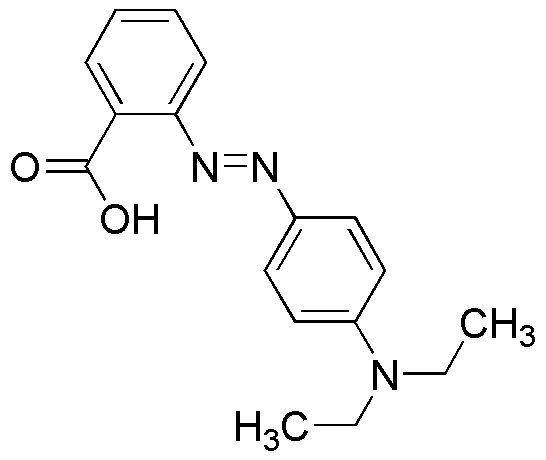Ethyl Red Indicator is widely utilized in research focused on:
- pH Indicator: Commonly used in titrations and laboratory experiments to visually indicate pH changes, making it easier for researchers to determine the acidity or alkalinity of solutions.
- Food Industry: Employed as a color additive in food products, providing a vibrant hue while also serving as a pH indicator during processing.
- Biochemical Research: Utilized in various assays to monitor changes in pH, which is crucial for understanding enzyme activity and metabolic processes.
- Textile Industry: Applied in dyeing processes, where it helps in determining the pH of dye baths, ensuring optimal color development and consistency.
- Environmental Monitoring: Used in water testing kits to assess the pH of samples, aiding in the detection of pollution and ensuring compliance with environmental regulations.
General Information
Properties
Safety and Regulations
Applications
Ethyl Red Indicator is widely utilized in research focused on:
- pH Indicator: Commonly used in titrations and laboratory experiments to visually indicate pH changes, making it easier for researchers to determine the acidity or alkalinity of solutions.
- Food Industry: Employed as a color additive in food products, providing a vibrant hue while also serving as a pH indicator during processing.
- Biochemical Research: Utilized in various assays to monitor changes in pH, which is crucial for understanding enzyme activity and metabolic processes.
- Textile Industry: Applied in dyeing processes, where it helps in determining the pH of dye baths, ensuring optimal color development and consistency.
- Environmental Monitoring: Used in water testing kits to assess the pH of samples, aiding in the detection of pollution and ensuring compliance with environmental regulations.
Documents
Safety Data Sheets (SDS)
The SDS provides comprehensive safety information on handling, storage, and disposal of the product.
Product Specification (PS)
The PS provides a comprehensive breakdown of the product’s properties, including chemical composition, physical state, purity, and storage requirements. It also details acceptable quality ranges and the product's intended applications.
Certificates of Analysis (COA)
Search for Certificates of Analysis (COA) by entering the products Lot Number. Lot and Batch Numbers can be found on a product’s label following the words ‘Lot’ or ‘Batch’.
Número de catálogo
Número de lote/lote
Certificates Of Origin (COO)
This COO confirms the country where the product was manufactured, and also details the materials and components used in it and whether it is derived from natural, synthetic, or other specific sources. This certificate may be required for customs, trade, and regulatory compliance.
Número de catálogo
Número de lote/lote
Safety Data Sheets (SDS)
The SDS provides comprehensive safety information on handling, storage, and disposal of the product.
DownloadProduct Specification (PS)
The PS provides a comprehensive breakdown of the product’s properties, including chemical composition, physical state, purity, and storage requirements. It also details acceptable quality ranges and the product's intended applications.
DownloadCertificates of Analysis (COA)
Search for Certificates of Analysis (COA) by entering the products Lot Number. Lot and Batch Numbers can be found on a product’s label following the words ‘Lot’ or ‘Batch’.
Número de catálogo
Número de lote/lote
Certificates Of Origin (COO)
This COO confirms the country where the product was manufactured, and also details the materials and components used in it and whether it is derived from natural, synthetic, or other specific sources. This certificate may be required for customs, trade, and regulatory compliance.


